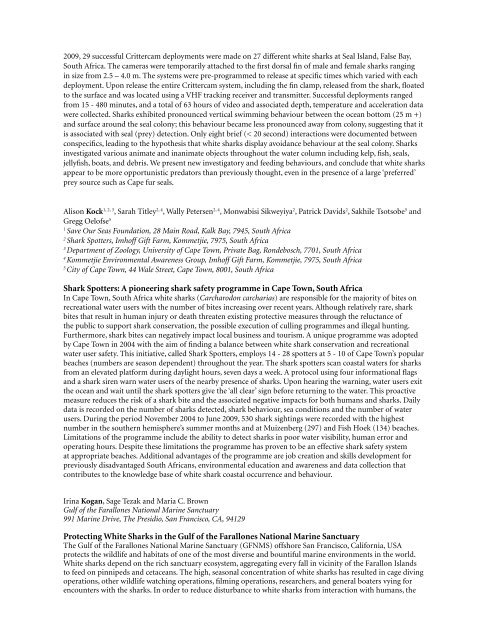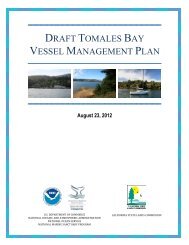Symposium program - Gulf of the Farallones National Marine ...
Symposium program - Gulf of the Farallones National Marine ...
Symposium program - Gulf of the Farallones National Marine ...
You also want an ePaper? Increase the reach of your titles
YUMPU automatically turns print PDFs into web optimized ePapers that Google loves.
2009, 29 successful Crittercam deployments were made on 27 different white sharks at Seal Island, False Bay,<br />
South Africa. The cameras were temporarily attached to <strong>the</strong> first dorsal fin <strong>of</strong> male and female sharks ranging<br />
in size from 2.5 – 4.0 m. The systems were pre-<strong>program</strong>med to release at specific times which varied with each<br />
deployment. Upon release <strong>the</strong> entire Crittercam system, including <strong>the</strong> fin clamp, released from <strong>the</strong> shark, floated<br />
to <strong>the</strong> surface and was located using a VHF tracking receiver and transmitter. Successful deployments ranged<br />
from 15 - 480 minutes, and a total <strong>of</strong> 63 hours <strong>of</strong> video and associated depth, temperature and acceleration data<br />
were collected. Sharks exhibited pronounced vertical swimming behaviour between <strong>the</strong> ocean bottom (25 m +)<br />
and surface around <strong>the</strong> seal colony; this behaviour became less pronounced away from colony, suggesting that it<br />
is associated with seal (prey) detection. Only eight brief (< 20 second) interactions were documented between<br />
conspecifics, leading to <strong>the</strong> hypo<strong>the</strong>sis that white sharks display avoidance behaviour at <strong>the</strong> seal colony. Sharks<br />
investigated various animate and inanimate objects throughout <strong>the</strong> water column including kelp, fish, seals,<br />
jellyfish, boats, and debris. We present new investigatory and feeding behaviours, and conclude that white sharks<br />
appear to be more opportunistic predators than previously thought, even in <strong>the</strong> presence <strong>of</strong> a large ‘preferred’<br />
prey source such as Cape fur seals.<br />
Alison Kock 1, 2, 3 , Sarah Titley 2, 4 , Wally Petersen 2, 4 , Monwabisi Sikweyiya 2 , Patrick Davids 2 , Sakhile Tsotsobe 5 and<br />
Gregg Oel<strong>of</strong>se 5<br />
1<br />
Save Our Seas Foundation, 28 Main Road, Kalk Bay, 7945, South Africa<br />
2<br />
Shark Spotters, Imh<strong>of</strong>f Gift Farm, Kommetjie, 7975, South Africa<br />
3<br />
Department <strong>of</strong> Zoology, University <strong>of</strong> Cape Town, Private Bag, Rondebosch, 7701, South Africa<br />
4<br />
Kommetjie Environmental Awareness Group, Imh<strong>of</strong>f Gift Farm, Kommetjie, 7975, South Africa<br />
5<br />
City <strong>of</strong> Cape Town, 44 Wale Street, Cape Town, 8001, South Africa<br />
Shark Spotters: A pioneering shark safety <strong>program</strong>me in Cape Town, South Africa<br />
In Cape Town, South Africa white sharks (Carcharodon carcharias) are responsible for <strong>the</strong> majority <strong>of</strong> bites on<br />
recreational water users with <strong>the</strong> number <strong>of</strong> bites increasing over recent years. Although relatively rare, shark<br />
bites that result in human injury or death threaten existing protective measures through <strong>the</strong> reluctance <strong>of</strong><br />
<strong>the</strong> public to support shark conservation, <strong>the</strong> possible execution <strong>of</strong> culling <strong>program</strong>mes and illegal hunting.<br />
Fur<strong>the</strong>rmore, shark bites can negatively impact local business and tourism. A unique <strong>program</strong>me was adopted<br />
by Cape Town in 2004 with <strong>the</strong> aim <strong>of</strong> finding a balance between white shark conservation and recreational<br />
water user safety. This initiative, called Shark Spotters, employs 14 - 28 spotters at 5 - 10 <strong>of</strong> Cape Town’s popular<br />
beaches (numbers are season dependent) throughout <strong>the</strong> year. The shark spotters scan coastal waters for sharks<br />
from an elevated platform during daylight hours, seven days a week. A protocol using four informational flags<br />
and a shark siren warn water users <strong>of</strong> <strong>the</strong> nearby presence <strong>of</strong> sharks. Upon hearing <strong>the</strong> warning, water users exit<br />
<strong>the</strong> ocean and wait until <strong>the</strong> shark spotters give <strong>the</strong> ‘all clear’ sign before returning to <strong>the</strong> water. This proactive<br />
measure reduces <strong>the</strong> risk <strong>of</strong> a shark bite and <strong>the</strong> associated negative impacts for both humans and sharks. Daily<br />
data is recorded on <strong>the</strong> number <strong>of</strong> sharks detected, shark behaviour, sea conditions and <strong>the</strong> number <strong>of</strong> water<br />
users. During <strong>the</strong> period November 2004 to June 2009, 530 shark sightings were recorded with <strong>the</strong> highest<br />
number in <strong>the</strong> sou<strong>the</strong>rn hemisphere’s summer months and at Muizenberg (297) and Fish Hoek (134) beaches.<br />
Limitations <strong>of</strong> <strong>the</strong> <strong>program</strong>me include <strong>the</strong> ability to detect sharks in poor water visibility, human error and<br />
operating hours. Despite <strong>the</strong>se limitations <strong>the</strong> <strong>program</strong>me has proven to be an effective shark safety system<br />
at appropriate beaches. Additional advantages <strong>of</strong> <strong>the</strong> <strong>program</strong>me are job creation and skills development for<br />
previously disadvantaged South Africans, environmental education and awareness and data collection that<br />
contributes to <strong>the</strong> knowledge base <strong>of</strong> white shark coastal occurrence and behaviour.<br />
Irina Kogan, Sage Tezak and Maria C. Brown<br />
<strong>Gulf</strong> <strong>of</strong> <strong>the</strong> <strong>Farallones</strong> <strong>National</strong> <strong>Marine</strong> Sanctuary<br />
991 <strong>Marine</strong> Drive, The Presidio, San Francisco, CA, 94129<br />
Protecting White Sharks in <strong>the</strong> <strong>Gulf</strong> <strong>of</strong> <strong>the</strong> <strong>Farallones</strong> <strong>National</strong> <strong>Marine</strong> Sanctuary<br />
The <strong>Gulf</strong> <strong>of</strong> <strong>the</strong> <strong>Farallones</strong> <strong>National</strong> <strong>Marine</strong> Sanctuary (GFNMS) <strong>of</strong>fshore San Francisco, California, USA<br />
protects <strong>the</strong> wildlife and habitats <strong>of</strong> one <strong>of</strong> <strong>the</strong> most diverse and bountiful marine environments in <strong>the</strong> world.<br />
White sharks depend on <strong>the</strong> rich sanctuary ecosystem, aggregating every fall in vicinity <strong>of</strong> <strong>the</strong> Farallon Islands<br />
to feed on pinnipeds and cetaceans. The high, seasonal concentration <strong>of</strong> white sharks has resulted in cage diving<br />
operations, o<strong>the</strong>r wildlife watching operations, filming operations, researchers, and general boaters vying for<br />
encounters with <strong>the</strong> sharks. In order to reduce disturbance to white sharks from interaction with humans, <strong>the</strong>







